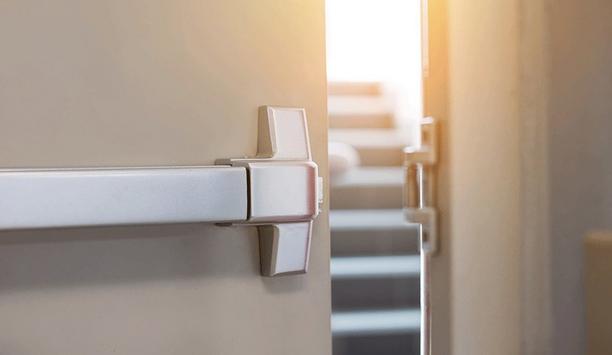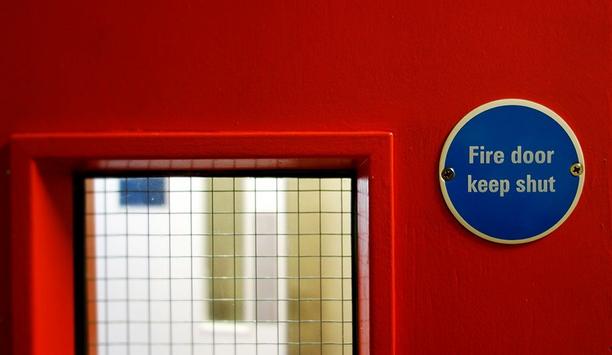Door closers are required to protect people and property, but they are left useless without the appropriate adjustments. Kirk Smith of Allegion UK explains the key elements of door closer adjustments and how to correctly approach each type.
Described as mechanically or electronically controlled closing devices, door closers are designed to open a door safely and close slowly but firmly enough to latch into place.
Importance of closing doors
When working as intended, closers play an integral role in a building’s operational safety, enabling a user to operate a door in a way that doesn’t harm them or damage the building. More importantly, a working door closer - whether concealed or surface mounted - will keep fire doors closed in the event of a fire, aiding in the compartmentalization of fire and smoke.
As part of their building safety advice published in 2020, the UK government recognized the significance of ‘compulsory closers’ and has urged decision-makers and residents to recognize the importance of a working self-closing device. Yet, a lack of sufficient maintenance and installation know-how often results in indoor closers not functioning as required.
Fundamental Safeguarding
If a door closer is adjusted incorrectly, it can leave doors slamming open and shut compromises fire safety
In their best practice guide, the Door Hardware Federation (DHF) states that a minimum power size 3 door closer must be used on fire doors. Additionally, to comply with UK Construction Products Regulations, controlled closing devices must be CE marked, and tested under BS EN 1154 standard and fire rated to BS EN 1634.
Aside from using non-compliant hardware, complications arise when a door closer isn’t adjusted correctly. Whether a door is opened manually, mechanically, or electronically, if its accompanying door closer is adjusted incorrectly, it can leave doors slamming open and shut and in some cases, failing to close completely. This compromises fire safety and building security – but it can be corrected.
Operations explained
Door closers operate by using spring tension, controlled by hydraulic fluid which passes from one section to the next as a door is opened. When the spring pushes the door closed again, the hydraulic fluid passes back to the previous section through a series of valves that control the speed of the mechanism.
The valves can be adjusted at the installation stage or regular maintenance periods, and assist in controlling the speed of the door operation.
Adjustments Explained
When adjusting a door closer, it’s essential to understand the type of correction a closer needs to operate in its desired way.
Most adjustments can be implemented by opening and closing the various hydraulic valves found on the body of the door closer. This can be completed by turning them with an Allen key or screwdriver to increase or decrease until the door closes in a safe and controlled manner.
Adjustable Closer Speed and Closer Power
PowerAdjust mechanism provides a visual guide on the EN power level at which the closer has been adjusted"
“In the first instance, if a door is closing with too little or too much speed, users are in danger of leaving the door ajar, or when slamming shut, damaging the surrounding walls or the door and hardware itself. This can lead to fire safety concerns and increased maintenance periods. With this in mind, it’s commonly recommended to locate and adjust the valves so that the fire door closes within a 5-7 second period from a 90-degree angle.”
“A PowerAdjust mechanism provides a visual guide on the EN power level at which the closer has been adjusted. This visual guide is useful in showing what strength a door is currently closing at and can detail how many valves turns are required to increase or decrease the power. This helps to avoid overtightening which endangers breaking the regulator oil seal. It’s also key to remember that a minimum power size 3 is required on any fire door.”
Adjustable Latch Action
“At its most crucial stage of the closing cycle, a door must often overcome seals and latches to close effectively. An unlatched door can facilitate the spread of smoke and fire and renders a fire door useless.”
“Adjustable latch action allows you to control the speed of the door in the final 15 degrees of the closing cycle, ensuring the door completes closing and isn’t left unlatched. In the event a door is closing too hard at the final stage, a closer can also be adjusted to soften the final 15 degrees, which helps avoid damage to the lock strike and frame.”
Adjustable Backcheck
“In some cases, a fire door may be opening too quickly and violently and when poorly adjusted, this can leave the door to jam on the closing cycle.”
“To prevent damage to the door or injury to persons standing behind it, we recommend adjusting the backcheck. Doing so will provide a cushioning effect, slowing the door down which is optimal for active building environments such as schools. Even after adjusting the closer, it’s always worth using doorstops.”
Adjustable Delayed Action
Maximum delay permissible on and a fire door should take no longer than 25 seconds to complete its closing cycle"
“A prolonged closing action is useful for busy environments such as schools, hospitals, and care homes – helping users pass through in adequate time.”
“By adjusting the delayed action, the speed at which the door closes can be set slower, giving people extra time to pass through the doorway. Adjustable timing is set between 70 degrees and 120 degrees. However, maximum delay permissible on and a fire door should take no longer than 25 seconds to complete its closing cycle.”
Adjustable Hold-open
“Although mechanical hold open door closers are for use on non-fire doors only, electromagnetic doors can safely implement hold-open door closers under fire safety standards.”
Fire door closers operating at optimal speed and strength are a prerequisite for comprehensive fire safety. When it comes to the installation and maintenance of fire door closers, it’s crucial to understand the intricacies of adjustments. After all, it’s never right to risk building safety or non-compliance.



















